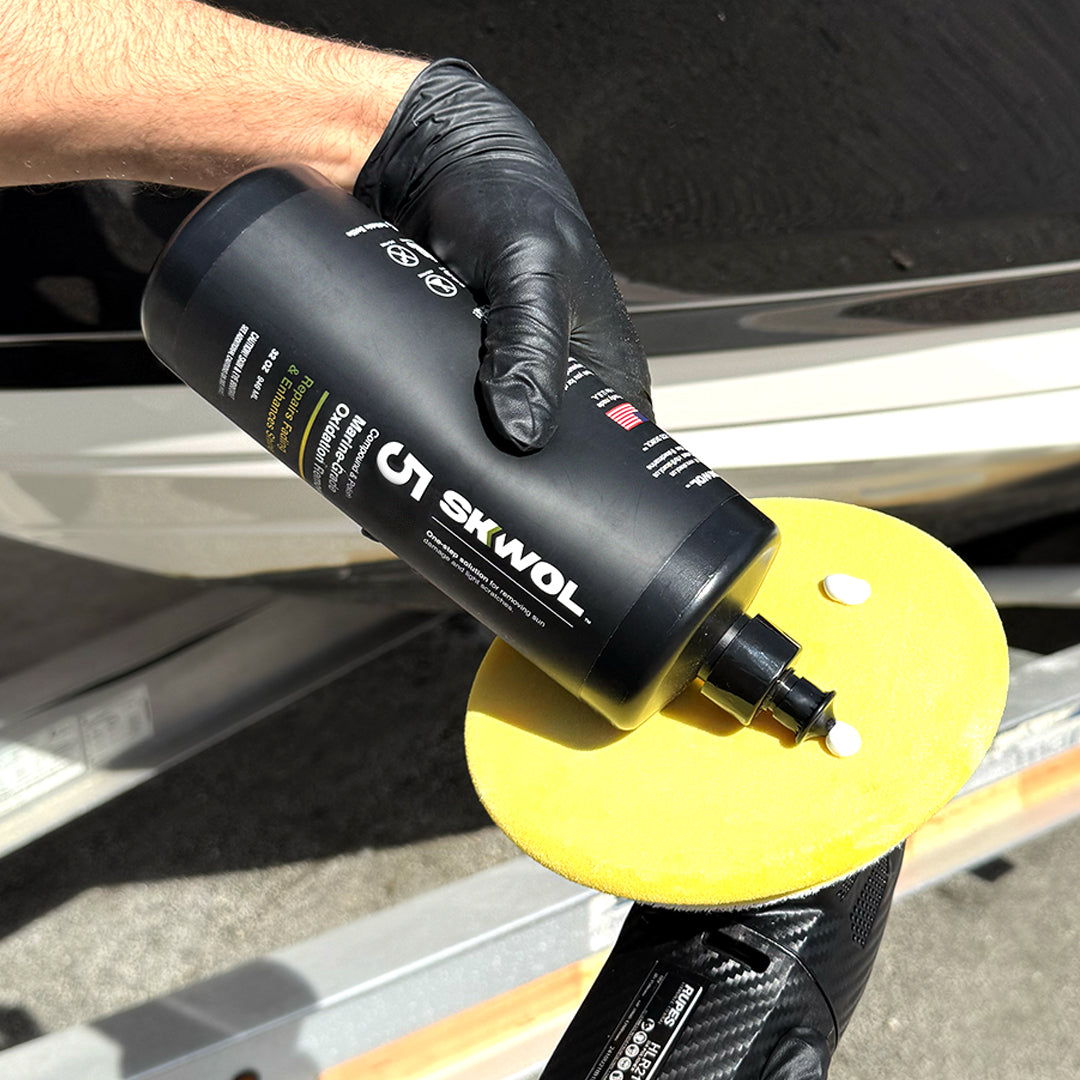1. Foam Pads: Precision and Versatility
Best for: Light oxidation removal, swirl correction, fine polishing, ceramic prep
Foam pads are the workhorses of boat detailing. They come in varying levels of density (from cutting to finishing) and are ideal for controlled correction and surface refinement.
-
Heavy-cut foam pads (often dark blue or grey)
➔ Use for: Mild to moderate oxidation, light sanding mark removal
➔ Ideal on: Gelcoat, painted surfaces -
Polishing foam pads (usually orange or light blue)
➔ Use for: Removing swirl marks, minor haze after compound stages
➔ Ideal on: Fresh gelcoat, clear coat touch-ups -
Finishing foam pads (usually black or red)
➔ Use for: Applying polishes, glazes, or ceramic coatings without cutting
➔ Ideal on: High-gloss gelcoat, delicate topcoats, new paint
Pro Tip: Foam absorbs product more than other pad types — be sure not to overload it, especially during finish work.
2. Wool Pads: The Oxidation Busters
Best for: Heavy oxidation removal, aggressive cutting
If your boat has years of sun damage, chalky gelcoat, or visible yellowing, wool is your best friend. Wool pads are incredibly aggressive and cut fast, leveling down damaged layers to reveal a fresh surface.
-
Twisted Wool Pads
➔ Use for: Maximum cut; removing deep oxidation and heavy pitting
➔ Ideal on: Older gelcoat, heavily oxidized fiberglass -
Wool Blend Pads (wool + synthetic fiber)
➔ Use for: Controlled cutting with slightly less aggressiveness and more finish
➔ Ideal on: Heavily oxidized gelcoat that still needs a smoother finish before polishing
Pro Tip: Wool generates more heat — keep the polisher moving to avoid surface burn. Always follow wool cutting with a foam polishing pad to refine the surface.
3. Microfiber Pads: A Hybrid Option
Best for: Moderate oxidation removal, one-step polish and finishing
Microfiber pads combine the aggression of wool with the control of foam, making them perfect for mid-stage correction where you need a strong cut but a cleaner finish.
-
Cutting Microfiber Pads
➔ Use for: Fast oxidation removal with less heat and less marring than wool
➔ Ideal on: Boats that are moderately oxidized but still have good underlying gelcoat -
Finishing Microfiber Pads
➔ Use for: Final glossing pass after microfiber cutting
➔ Ideal on: Metallic paints, newer gelcoats, dark-colored boats (to minimize haze)
Pro Tip: Microfiber pads can clog with oxidation quickly — clean them with compressed air or a pad brush frequently during use.
4. Specialty Pads: For Specific Needs
-
Marine-Specific Heavy Cut Pads
Some brands make extra dense pads specifically for marine-grade compounds. These are great if you're working with thick, stubborn gelcoat that automotive pads can't handle. -
Uro-Fiber Pads
A newer innovation — these ultra-thin microfiber pads excel at one-step polish jobs, especially on well-maintained boats that just need a refresh.
Final Thoughts: Pad and Surface Matching is Key
In boat detailing, there’s no "one-pad-fits-all" approach.
-
Heavily oxidized? Start aggressive with wool.
-
Moderately faded? Microfiber cutting pads are your friend.
-
Light swirls or haze? Foam polishing pads will perfect the finish.
-
Just enhancing gloss? A soft foam or microfiber finishing pad is all you need.
And remember:
The pad you use is just as important as the polish you choose.
The wrong pad can either cut too much, too little, or leave unnecessary haze behind.For the ultimate finish, always work progressively — starting with the least aggressive method first and stepping up only when needed.
-



Share:
Why It's Time to Ditch the Big Brands: The Hidden Advantages of Choosing a Newer Boat Detailing Company
The Truth About Boat Oxidation Removal: Why Wet-Sanding Isn’t Always the Answer